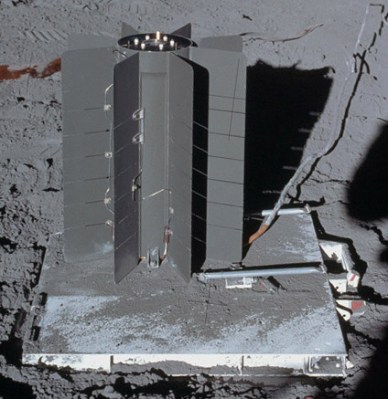
Launched in 1977, the Voyager 1 and 2 space probes have been operating non-stop for over 45 years, making their way from Earth to our solar system’s outer planets and beyond. Courtesy of the radioisotope thermoelectric generators (RTGs) which provided 470 W at launch, they are able to function in the darkness of Deep Space as well as they did within the confines of our Sun-lit solar system. Yet as nothing in the Universe is really infinite, so too do these RTGs wear out over time, both from natural decay of their radioactive source and from the degradation of the thermocouples.
Despite this gradual drop in power, NASA recently announced that Voyager 2 has a hitherto seemingly unknown source of reserve power that will postpone the shutdown of more science instruments for a few more years. The change essentially bypasses a voltage regular circuit and associated backup power system, freeing up the power consumed by this for the scientific instruments which would otherwise have begun to shut down years sooner.
While this is good news in itself, it’s also noteworthy because the Voyager’s 45+ year old Multi-Hundred Watt (MHW) RTGs are the predecessor to the RTGs that are still powering the New Horizons probe after 17 years, and the Mars Science Laboratory (Curiosity) for over 10 years, showing the value of RTGs in long-term exploration missions.
Although the basic principle behind an RTG is quite simple, their design has changed significantly since the US put a SNAP-3 RTG on the Transit 4B satellite in 1961.
Need For Power

Even on Earth it can be tough to find a reliable source of power that will last for years or even decades, which is why NASA’s Systems for Nuclear Auxiliary Power (SNAP) development program produced RTGs intended for both terrestrial and space-based use, with the SNAP-3 being the first to make it to space. This specific RTG produced a mere 2.5 W, and the satellites also had solar panels and NiCd batteries. But as a space-based RTG test bed, SNAP-3 laid the groundwork for successive NASA missions.
The SNAP-19 provided the power (~30 W per RTG) for the Viking 1 and 2 landers, as well as Pioneer 10 and 11. Five SNAP-27 units provided the power for the Apollo Lunar Surface Experiments Packages (ALSEP) that were left on the Moon by the Apollo 12, 14, 15, 16, and 17 astronauts. Each SNAP-27 unit provided approximately 75 W at 30 VDC of power from its 3.8 kg plutonium-238 fuel rod that was rated for 1,250 W thermally. After ten years, a SNAP-27 still produces over 90% of its rated electrical power, allowing each ALSEP to transmit data on moonquakes and other information recorded by its instruments for as long as the power budget allows.
By the time the Apollo project’s support operations were wound down in 1977, the ALSEPs were left with only their transmitters turned on. Apollo 13’s SNAP-27 unit (attached to the outside of the lunar module) made a re-entry to Earth, where it still lies – intact – at the bottom of the Tonga Trench in the Pacific Ocean.
The relative inefficiency of RTGs was readily apparent even back then, with the SNAP-10A experiment demonstrating a compact 500 W fission reactor in an ion-drive satellite that readily outperformed the SNAP RTGs. Although much more powerful per unit volume and nuclear fuel, thermocouple-based RTGs do have the advantage of absolutely zero moving parts and only passive cooling requirements. This allows for them to be literally stuck on a space probe, satellite or vehicle with thermal radiation and/or convection providing the cold side for the thermocouple.
These thermocouples employ the Seebeck effect, the Peltier effect in reverse, to turn the thermal gradient between two dissimilar electrically conductive materials into essentially a generator. Much of the challenge with thermocouple-based RTGs has been to find the most efficient and durable composition. Although Rankine-, Brayton- and Stirling-cycle RTGs have also been experimented with, these have the distinct disadvantage of moving mechanical parts, requiring seals and lubrication.
When considering the 45+ year lifespan of the Voyager MHW-RTGs with their relatively ancient silicon-germanium (SiGe) thermocouples, the disadvantages of adding mechanical components should be obvious. Especially when considering the MHW RTG two generations of successors so far.
Not Your 1970s RTG
While Voyager’s MHW-RTG was developed specifically for the mission by NASA, its successor, the creatively titled general-purpose heat source (GPHS) RTG, was designed by General Electric’s Space Division and subsequently used on the Ulysses (1990 – 2009), Galileo (1989 – 2003), Cassini-Huygens (1997 – 2017) and New Horizons (2006 – ) missions. Each GPHS-RTG produces about 300 W of electrical power from 4,400 W thermal, using still similar silicon-germanium thermocouples.
An interesting sidenote here is that even the solar-powered Mars rovers include a radioisotope unit, although in the form of a radioisotope heater unit (RHU), with the Sojourner Rover having three of these RHUs, and Spirit & Opportunity eight RHUs each. These RHUs provide a constant source of heat that allows scarce electricity from solar panels and batteries to be used for duties other than running heaters.

Meanwhile, the currently active Mars rovers, Curiosity and its twin Perseverance, get both electrical power and heat from a single multi-mission radioisotope thermoelectric generator (MMRTG) unit. These RTGs use PbTe/TAGS thermoelectric couples, meaning lead/tellurium alloy for one side and tellurium (Te), silver (Ag), germanium (Ge) and antimony (Sb) for the other side of the couple. The MMRTG is rated for a lifespan of up to 17 years, but is likely to outperform its design specifications by a considerable margin like the MHW-RTGs and others have. The Pu-238 fuel with an MMRTG is contained in General Purpose Heat Source (GPHS) modules, which serve to protect the fuel from damage.
The main failure mode of the SiGe thermocouples was migration of the germanium over time, which causes sublimation. This was prevented in later designs by coating the SiGe thermocouples with silicon nitride. The PbTe/TAGS thermocouples should provide further stability in this regard, and the MMRTGs in Curiosity and Perseverance have served as real-world duration tests.
A Matter Of Fuel
The Voyager 1 and 2 probes are well out of reach for a big service and maintenance session, so NASA had to get creative to optimize power usage. Although the backup power circuit was perhaps considered a necessity back in the 1970s in case there were power fluctuations from any of the three RTGs on each space probe, there is enough real-life monitoring data to support the suggestion that it may be superfluous, barring alien influences.
With the nearly 46 years of data from the Voyager RTGs, we can see now that thermocouple stability is essential to maintain a constant power output, with the decay of the plutonium-238 fuel source significantly easier to model and predict. Now that with the MMRTG units we should have addressed many of the issues that caused degradation of the thermocouples over time. The only missing ingredient is the Pu-238 fuel.
Most of the Pu-238 that the US had originally came from the Savannah River Site (SRS) before this facility and its special reactors was shutdown in 1988. After this the US would import Pu-238 from Russia before the latter’s stocks would also begin to run low, leading to the awkward position of the US running out of what is one of the best radioactive isotopes to use in RTGs for long-duration missions. With a short half-life of 87.7 years and only alpha decay, Pu-238 is both rather benign to surrounding materials, while providing significant amounts of thermal power.
With only enough Pu-238 left for the two MMRTGs in the current Mars rovers and two more after these, the US has now restarted Pu-238 production. Although Pu-238 can be created via a few different ways, the preferred way appears to be to use stockpiled neptunium-237 and expose it to neutrons in fission reactors or similar neutron sources, to generate Pu-238 via neutron capture. According to NASA, about 1.5 kg of Pu-238 per year should be enough to satisfy demand for future space missions.
A Tiny Spacecraft In The Dark
Voyager 1 is currently at a distance of 159.14 AU (23.807 billion km) from Earth, and Voyager 2 is only marginally closer at 133.03 AU from Earth. As a project that has its roots in the Space Race and has ended up outliving not only many of its creators, but also the geopolitics of the time, it is perhaps one of the few human-made constants with which we can all identify in some fashion.
As carriers of the golden discs that contain the essence of humanity, extending the life of these spacecraft goes beyond merely the science they can perform, out in the darkness of Deep Space. With every year extra we may learn a bit more and see a bit more of what awaits humanity beyond the reaches of this rather ordinary, out of the way solar system.
NASA’s Voyager Space Probe’s Reserve Power, and the Intricacies of RTG-Based Power Systems
Source: Manila Flash Report
0 Comments